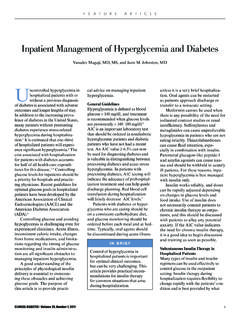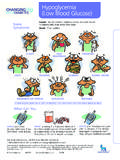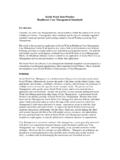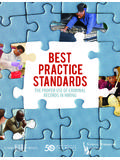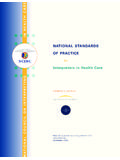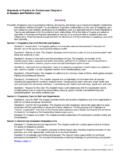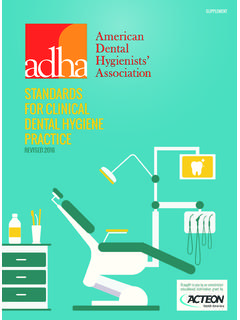Transcription of The Scope of Practice, Standards of Practice, and ...
1 1 The Scope of practice , Standards of practice , and Standards of professional performance for diabetes educators Introduction The Scope of practice , Standards of practice , and Standards of professional performance for diabetes educators has been developed by the AADE to define the Scope , role, and minimal level of quality performance of the diabetes educator; to differentiate diabetes education as a distinct healthcare specialty; to promote diabetes self-management education and training (DSME/T) as an integral part of diabetes care; and to facilitate excellence. Representing the expertise and experience of a multidisciplinary task force of health professionals representative of the AADE membership and an extensive review process embracing a broad spectrum of practice areas, this document supports the specialty by.
2 Stimulating the process of peer review, Promoting documentation of the outcomes of DSME/T, Encouraging research to validate practice and improve quality DSME/T and diabetes care, Engaging in a process of critical examination of current diabetes educator practice and professional performance , and Complementing other practice-related documents that address the delivery of DSME/T by diabetes educators and roles of other healthcare practitioners who are members of the diabetes care team. diabetes education is unique in that its practitioners come from a variety of health disciplines. diabetes educators remain individually accountable to the Standards set by the discipline and by national, state, local, and institutional regulations that define and guide professional practice.
3 This document serves to guide diabetes educators practice regardless of their professional discipline. Background Living well with diabetes requires active, diligent, effective self-management of the Self-management is an important concept to emphasize because persons with diabetes make choices and act on choices that affect their health on a regular and recurring basis. Similarly, people with pre- diabetes must be engaged in recognizing and addressing individual risk factors and acting on choices that affect their health. Effective self-management is a process that includes learning the body of 2 knowledge relevant to the disease state, defining personal goals, weighing the benefits and risks of various treatment options, making informed choices about treatment, developing skills (both physical and behavioral) to support those choices, and evaluating the efficacy of the plan toward reaching self-defined goals.
4 DSME/T is impacted by the rising number of cases of pre- diabetes , metabolic syndrome, and diabetes in the United States; the possibilities of preventing and delaying the onset of type 2 diabetes ; and the value of early and aggressive diabetes management. The diabetes Epidemic Today, million people in the United States have diabetes million diagnosed cases; in addition there are an estimated million undiagnosed The number of persons with diabetes represents of the total US population and of the population older than 20 years. Most people with diabetes (90%-95%) have type 2 Worldwide, the number of people with diabetes is expected to increase by 35% by the year The CDC estimates that 57 million American adults meet the diagnostic criteria for Pre- diabetes increases the risk for developing diabetes and is an independent risk factor for cardiovascular Despite improvements in diabetes treatment, a recent report concluded that the proportion of adults in the United States with diagnosed type 2 diabetes that is controlled is inadequate and less favorable today than in previous ,8 diabetes remains the leading cause of new blindness, renal failure.
5 And nontraumatic amputations in the United States. Hypertension, dyslipidemia, and obesity are highly associated with diabetes and pre- diabetes , as are other cardiovascular, cerebrovascular, and peripheral vascular ,9 The annual economic burden of diabetes was estimated at more than $174 billion (direct and indirect costs) in ,9 diabetes Prevention There are no proven methods to prevent or delay type 1 diabetes , although studies are underway and more are planned. There is, however, evidence suggesting that type 2 diabetes can be prevented or delayed. The diabetes Prevention Program showed a 58% relative reduction in the progression from pre- diabetes to diabetes in the lifestyle group (which received intensive nutrition and exercise counseling) as well as a 31% relative reduction in the group treated with ,11 A Finnish study likewise demonstrated a 58% relative reduction in progression to diabetes in intervention group subjects.
6 These subjects were encouraged to lose weight, reduce dietary fat and saturated fat intake, increase fiber intake, and participate in regular Additional research examining the impact of lifestyle intervention in the area of diabetes and obesity will continue to inform practice. Identifying people at risk for diabetes is the critical first step in preventing the The term pre - diabetes was adopted in 2002 to describe impaired glucose tolerance or impaired fasting glucose, to 3 promote awareness of the importance of pre- diabetes screenings, and to spread the encouraging news that diabetes may be Physical and behavioral characteristics used to identify persons at risk for diabetes and pre- diabetes include obesity, sedentary lifestyle, history of hypertension, dyslipidemia, family history of diabetes , gestational history, and ethnicity.
7 These risk factors may be assessed by various means, many of which align with , Formal diagnosis of pre- diabetes or diabetes (in the absence of overt diabetes symptoms and elevated blood glucose levels) is made with a fasting plasma glucose test, oral glucose tolerance test or Effective, safe, and low-cost interventions for preventing diabetes include changing nutrition and physical activity Medications are also effective, and while not without risk, side effects are minimal. Use of a single agent for prevention may negate the need for multiple agents to treat overt diabetes and reduce future costs associated with diabetes complications.
8 While prevention strategies are not without cost or resources, they are proven to be diabetes educators diabetes educators are healthcare professionals who have experience in the care of people with diabetes and have achieved a core body of knowledge and skills in the biological and social sciences, communication, counseling, and education. Mastery of the knowledge and skills to become a diabetes educator is obtained through formal, practical and continuing education, individual study, and mentorship. The role of the diabetes educator can be assumed by professionals from a variety of health disciplines, including, but not limited to, registered nurses, registered dietitians, registered pharmacists, physicians, mental health professionals, podiatrists, optometrists, and exercise The diabetes educator is an integral partner in the diabetes care ,17 The diabetes educator understands the impact of acute or chronic problems on a person s health behaviors and lifestyle and on the teaching/learning.
9 18 Such appreciation is essential for the development of a comprehensive plan for continuing education and cost effective, self-care management. All diabetes educators , no matter their discipline, provide all aspects of DSME/T. It is recognized that members of the various healthcare disciplines who practice diabetes education bring their particular focus to the educational process. This widens or narrows the Scope of practice for individual educators as is appropriate within the boundaries of each health profession, which may be regulated by national or state agencies or accrediting bodies. Regardless of discipline, the diabetes educator must be prepared to provide clients with the knowledge and skills to effectively manage their diabetes .
10 diabetes educators must possess a body of knowledge that spans across disciplines to provide comprehensive DSME/T. Multi-level diabetes Education Team 4 The multi-level diabetes education team approach recognizes the key role of the advanced level educator as well as the importance and contributions of lay health and community workers who are uniquely positioned to collaborate with diabetes educators and other healthcare providers to improve the quality of diabetes care in Given the diversity of DSME/T providers and skill levels, it is necessary to delineate levels of practice for the delivery of DSME/T.

